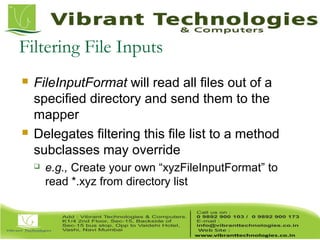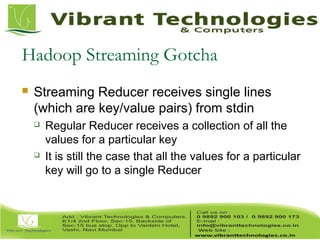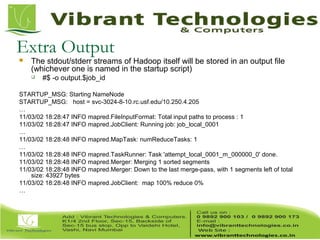Hadoop - Introduction to mapreduce
- 3. Terminology Google calls it: Hadoop equivalent: MapReduce Hadoop GFS HDFS Bigtable HBase Chubby Zookeeper
- 4. Some MapReduce Terminology Job – A “full program” - an execution of a Mapper and Reducer across a data set Task – An execution of a Mapper or a Reducer on a slice of data a.k.a. Task-In-Progress (TIP) Task Attempt – A particular instance of an attempt to execute a task on a machine
- 5. Task Attempts A particular task will be attempted at least once, possibly more times if it crashes If the same input causes crashes over and over, that input will eventually be abandoned Multiple attempts at one task may occur in parallel with speculative execution turned on Task ID from TaskInProgress is not a unique identifier; don’t use it that way
- 6. MapReduce: High Level In our case: circe.rc.usf.edu
- 7. Nodes, Trackers, Tasks Master node runs JobTracker instance, which accepts Job requests from clients TaskTracker instances run on slave nodes TaskTracker forks separate Java process for task instances
- 8. Job Distribution MapReduce programs are contained in a Java “jar” file + an XML file containing serialized program configuration options Running a MapReduce job places these files into the HDFS and notifies TaskTrackers where to retrieve the relevant program code … Where’s the data distribution?
- 9. Data Distribution Implicit in design of MapReduce! All mappers are equivalent; so map whatever data is local to a particular node in HDFS If lots of data does happen to pile up on the same node, nearby nodes will map instead Data transfer is handled implicitly by HDFS
- 10. What Happens In Hadoop? Depth First
- 11. Job Launch Process: Client Client program creates a JobConf Identify classes implementing Mapper and Reducer interfaces JobConf.setMapperClass(), setReducerClass() Specify inputs, outputs FileInputFormat.setInputPath(), FileOutputFormat.setOutputPath() Optionally, other options too: JobConf.setNumReduceTasks(), JobConf.setOutputFormat()…
- 12. Job Launch Process: JobClient Pass JobConf to JobClient.runJob() or submitJob() runJob() blocks, submitJob() does not JobClient: Determines proper division of input into InputSplits Sends job data to master JobTracker server
- 13. Job Launch Process: JobTracker JobTracker: Inserts jar and JobConf (serialized to XML) in shared location Posts a JobInProgress to its run queue
- 14. Job Launch Process: TaskTracker TaskTrackers running on slave nodes periodically query JobTracker for work Retrieve job-specific jar and config Launch task in separate instance of Java main() is provided by Hadoop
- 15. Job Launch Process: Task TaskTracker.Child.main(): Sets up the child TaskInProgress attempt Reads XML configuration Connects back to necessary MapReduce components via RPC Uses TaskRunner to launch user process
- 16. Job Launch Process: TaskRunner TaskRunner, MapTaskRunner, MapRunner work in a daisy-chain to launch your Mapper Task knows ahead of time which InputSplits it should be mapping Calls Mapper once for each record retrieved from the InputSplit Running the Reducer is much the same
- 17. Creating the Mapper You provide the instance of Mapper Should extend MapReduceBase One instance of your Mapper is initialized by the MapTaskRunner for a TaskInProgress Exists in separate process from all other instances of Mapper – no data sharing!
- 18. Mapper void map(K1 key, V1 value, OutputCollector<K2, V2> output, Reporter reporter) K types implement WritableComparable V types implement Writable
- 19. What is Writable? Hadoop defines its own “box” classes for strings (Text), integers (IntWritable), etc. All values are instances of Writable All keys are instances of WritableComparable
- 21. Reading Data Data sets are specified by InputFormats Defines input data (e.g., a directory) Identifies partitions of the data that form an InputSplit Factory for RecordReader objects to extract (k, v) records from the input source
- 22. FileInputFormat and Friends TextInputFormat – Treats each ‘n’-terminated line of a file as a value KeyValueTextInputFormat – Maps ‘n’- terminated text lines of “k SEP v” SequenceFileInputFormat – Binary file of (k, v) pairs with some add’l metadata SequenceFileAsTextInputFormat – Same, but maps (k.toString(), v.toString())
- 23. Filtering File Inputs FileInputFormat will read all files out of a specified directory and send them to the mapper Delegates filtering this file list to a method subclasses may override e.g., Create your own “xyzFileInputFormat” to read *.xyz from directory list
- 24. Record Readers Each InputFormat provides its own RecordReader implementation Provides (unused?) capability multiplexing LineRecordReader – Reads a line from a text file KeyValueRecordReader – Used by KeyValueTextInputFormat
- 25. Input Split Size FileInputFormat will divide large files into chunks Exact size controlled by mapred.min.split.size RecordReaders receive file, offset, and length of chunk Custom InputFormat implementations may override split size – e.g., “NeverChunkFile”
- 26. Sending Data To Reducers Map function receives OutputCollector object OutputCollector.collect() takes (k, v) elements Any (WritableComparable, Writable) can be used By default, mapper output type assumed to be same as reducer output type
- 27. WritableComparator Compares WritableComparable data Will call WritableComparable.compare() Can provide fast path for serialized data JobConf.setOutputValueGroupingComparator()
- 28. Sending Data To The Client Reporter object sent to Mapper allows simple asynchronous feedback incrCounter(Enum key, long amount) setStatus(String msg) Allows self-identification of input InputSplit getInputSplit()
- 30. Partitioner int getPartition(key, val, numPartitions) Outputs the partition number for a given key One partition == values sent to one Reduce task HashPartitioner used by default Uses key.hashCode() to return partition num JobConf sets Partitioner implementation
- 31. Reduction reduce( K2 key, Iterator<V2> values, OutputCollector<K3, V3> output, Reporter reporter ) Keys & values sent to one partition all go to the same reduce task Calls are sorted by key – “earlier” keys are reduced and output before “later” keys
- 32. Finally: Writing The Output
- 33. OutputFormat Analogous to InputFormat TextOutputFormat – Writes “key valn” strings to output file SequenceFileOutputFormat – Uses a binary format to pack (k, v) pairs NullOutputFormat – Discards output Only useful if defining own output methods within reduce()
- 34. Example Program - Wordcount map() Receives a chunk of text Outputs a set of word/count pairs reduce() Receives a key and all its associated values Outputs the key and the sum of the values package org.myorg; import java.io.IOException; import java.util.*; import org.apache.hadoop.fs.Path; import org.apache.hadoop.conf.*; import org.apache.hadoop.io.*; import org.apache.hadoop.mapred.*; import org.apache.hadoop.util.*; public class WordCount {
- 35. Wordcount – main( ) public static void main(String[] args) throws Exception { JobConf conf = new JobConf(WordCount.class); conf.setJobName("wordcount"); conf.setOutputKeyClass(Text.class); conf.setOutputValueClass(IntWritable.class); conf.setMapperClass(Map.class); conf.setReducerClass(Reduce.class); conf.setInputFormat(TextInputFormat.class); conf.setOutputFormat(TextOutputFormat.class); FileInputFormat.setInputPaths(conf, new Path(args[0])); FileOutputFormat.setOutputPath(conf, new Path(args[1])); JobClient.runJob(conf); }
- 36. Wordcount – map( ) public static class Map extends MapReduceBase … { private final static IntWritable one = new IntWritable(1); private Text word = new Text(); public void map(LongWritable key, Text value, OutputCollector<Text, IntWritable> output, …) … { String line = value.toString(); StringTokenizer tokenizer = new StringTokenizer(line); while (tokenizer.hasMoreTokens()) { word.set(tokenizer.nextToken()); output.collect(word, one); } } }
- 37. Wordcount – reduce( ) public static class Reduce extends MapReduceBase … { public void reduce(Text key, Iterator<IntWritable> values, OutputCollector<Text, IntWritable> output, …) … { int sum = 0; while (values.hasNext()) { sum += values.next().get(); } output.collect(key, new IntWritable(sum)); } } }
- 38. Hadoop Streaming Allows you to create and run map/reduce jobs with any executable Similar to unix pipes, e.g.: format is: Input | Mapper | Reducer echo “this sentence has five lines” | cat | wc
- 39. Hadoop Streaming Mapper and Reducer receive data from stdin and output to stdout Hadoop takes care of the transmission of data between the map/reduce tasks It is still the programmer’s responsibility to set the correct key/value Default format: “key t valuen” Let’s look at a Python example of a MapReduce word count program…
- 40. Streaming_Mapper.py # read in one line of input at a time from stdin for line in sys.stdin: line = line.strip() # string words = line.split() # list of strings # write data on stdout for word in words: print ‘%st%i’ % (word, 1)
- 41. Hadoop Streaming What are we outputting? Example output: “the 1” By default, “the” is the key, and “1” is the value Hadoop Streaming handles delivering this key/value pair to a Reducer Able to send similar keys to the same Reducer or to an intermediary Combiner
- 42. Streaming_Reducer.py wordcount = { } # empty dictionary # read in one line of input at a time from stdin for line in sys.stdin: line = line.strip() # string key,value = line.split() wordcount[key] = wordcount.get(key, 0) + value # write data on stdout for word, count in sorted(wordcount.items()): print ‘%st%i’ % (word, count)
- 43. Hadoop Streaming Gotcha Streaming Reducer receives single lines (which are key/value pairs) from stdin Regular Reducer receives a collection of all the values for a particular key It is still the case that all the values for a particular key will go to a single Reducer
- 44. Using Hadoop Distributed File System (HDFS) Can access HDFS through various shell commands (see Further Resources slide for link to documentation) hadoop –put <localsrc> … <dst> hadoop –get <src> <localdst> hadoop –ls hadoop –rm file
- 45. Configuring Number of Tasks Normal method jobConf.setNumMapTasks(400) jobConf.setNumReduceTasks(4) Hadoop Streaming method -jobconf mapred.map.tasks=400 -jobconf mapred.reduce.tasks=4 Note: # of map tasks is only a hint to the framework. Actual number depends on the number of InputSplits generated
- 46. Running a Hadoop Job Place input file into HDFS: hadoop fs –put ./input-file input-file Run either normal or streaming version: hadoop jar Wordcount.jar org.myorg.Wordcount input-file output-file hadoop jar hadoop-streaming.jar -input input-file -output output-file -file Streaming_Mapper.py -mapper python Streaming_Mapper.py -file Streaming_Reducer.py -reducer python Streaming_Reducer.py
- 47. Submitting to RC’s GridEngine Add appropriate modules module add apps/jdk/1.6.0_22.x86_64 apps/hadoop/0.20.2 Use the submit script posted in the Further Resources slide Script calls internal functions hadoop_start and hadoop_end Adjust the lines for transferring the input file to HDFS and starting the hadoop job using the commands on the previous slide Adjust the expected runtime (generally good practice to overshoot your estimate) #$ -l h_rt=02:00:00 NOTICE: “All jobs are required to have a hard run-time specification. Jobs that do not have this specification will have a default run-time of 10 minutes and will be stopped at that point.”
- 48. Output Parsing Output of the reduce tasks must be retrieved: hadoop fs –get output-file hadoop-output This creates a directory of output files, 1 per reduce task Output files numbered part-00000, part-00001, etc. Sample output of Wordcount head –n5 part-00000 “’tis 1 “come 2 “coming 1 “edwin 1 “found 1
- 49. Extra Output The stdout/stderr streams of Hadoop itself will be stored in an output file (whichever one is named in the startup script) #$ -o output.$job_id STARTUP_MSG: Starting NameNode STARTUP_MSG: host = svc-3024-8-10.rc.usf.edu/10.250.4.205 … 11/03/02 18:28:47 INFO mapred.FileInputFormat: Total input paths to process : 1 11/03/02 18:28:47 INFO mapred.JobClient: Running job: job_local_0001 … 11/03/02 18:28:48 INFO mapred.MapTask: numReduceTasks: 1 … 11/03/02 18:28:48 INFO mapred.TaskRunner: Task 'attempt_local_0001_m_000000_0' done. 11/03/02 18:28:48 INFO mapred.Merger: Merging 1 sorted segments 11/03/02 18:28:48 INFO mapred.Merger: Down to the last merge-pass, with 1 segments left of total size: 43927 bytes 11/03/02 18:28:48 INFO mapred.JobClient: map 100% reduce 0% …
- 50. Thank You !!! For More Information click below link: Follow Us on: http://vibranttechnologies.co.in/hadoop-classes-in-mumbai.html



































![Wordcount – main( )
public static void main(String[] args) throws Exception {
JobConf conf = new JobConf(WordCount.class);
conf.setJobName("wordcount");
conf.setOutputKeyClass(Text.class);
conf.setOutputValueClass(IntWritable.class);
conf.setMapperClass(Map.class);
conf.setReducerClass(Reduce.class);
conf.setInputFormat(TextInputFormat.class);
conf.setOutputFormat(TextOutputFormat.class);
FileInputFormat.setInputPaths(conf, new Path(args[0]));
FileOutputFormat.setOutputPath(conf, new Path(args[1]));
JobClient.runJob(conf);
}](https://image.slidesharecdn.com/introductiontomapreduce-160417105952/85/Hadoop-Introduction-to-mapreduce-35-320.jpg)






![Streaming_Reducer.py
wordcount = { } # empty dictionary
# read in one line of input at a time from stdin
for line in sys.stdin:
line = line.strip() # string
key,value = line.split()
wordcount[key] = wordcount.get(key, 0) + value
# write data on stdout
for word, count in sorted(wordcount.items()):
print ‘%st%i’ % (word, count)](https://image.slidesharecdn.com/introductiontomapreduce-160417105952/85/Hadoop-Introduction-to-mapreduce-42-320.jpg)





































































































![Iobit Driver Booster Pro Crack Free Download [Latest] 2025](https://cdn.slidesharecdn.com/ss_thumbnails/informationtechnology5-250522164349-8a98d122-thumbnail.jpg?width=560&fit=bounds)



